bluemanc said:
You may well have a degree in chemistry but i'll bet you don't have a full set of fingers with all the guessing you are doing.
Was it tested or used anywhere else ?did anything else get burned?etc
To suggest you have any idea what was used and to then state what effect the made up chemical you have guessed was used would have on the bridge and surrounding area is hardly the solid groundwork theory of someone with a chem degree.,i'm shocked by that chem degree thing btw.
Any number of solvents/accelerants used in the workplace can do serious damage ,honestly,but you knew that didnt you.
Buy over a shop counter,pmsl.
You're right, this is mostly guesswork, but I do in fact have a chemistry degree. This means I am more qualified than you to make assumptions about flammability based on what I have seen in the photographs.
I'll explain why I'm assuming that BBQ lighter fluid was used and then you can explain your reasoning.
The flames look like flames from lighter fluid. It's not fully combusting, there is a yellow flame. That effectively rules out spirits and most accelerants. Incomplete combustion usually creates smoke (soot, carbon). That makes bricks go black. It doesn't damage them, it makes them dirty.
They haven't completely doused the effigy. This implies a thoroughly slapdash effort, which makes me think that they haven't put very much thought or planning into it at all. They might, however, have reliased they might have to squirt it, and thus bought a bottle of BBQ lighter fluid, which you can squirt. Or, they couldn't reach, so they just doused cigarette lighter fluid on its legs.
It clearly was bought over a shop counter because a shop is where you would buy BBQ lighter fluid and generally, people who work for media agencies don't have highly flammable chemicals lying around the workplace, and don't have an account with a supplier of accelerants, which clearly weren't used anyway (see above) and even if we assume this wasn't a setup, the sort of people who are intending to set fire to things would not generally be daft enough to steal those items from their workplace, when they could just walk into a shop and buy some lighter fluid over the counter or into a petrol station with a jerry can and buy some petrol.
So it could have been petrol.
All volatile chemicals evaporate and most are immiscible with water. Pouring volatile organic chemicals into the drains can cause damage to wildlife. If one person does it, that potential for damage is minimal. If everyone does it, the potential is massive.
Do you know how long it takes for a brick to heat up from such a small, short-lived, moderate heat source?
Let alone a number of bricks.
Let alone why the bricks would be damaged, yet the effigy's paper face remains largely undamaged.
Let alone why they build chimneys out of bricks.
Do you know how long it took Fred Dibnah to fell a chimney?
And for the avoidance of doubt, may I suggest you put a brick in a bonfire on Nov 5th and tell me what's left behind on Nov 6th. You should find some ash, probably some rusty nails, and a brick.
I assume you don't work for CID or forensics if you are shocked that I have a Masters in Chemistry. The mere mention of specific heat capacity in this scenario should have been a hint that I might well know what I'm talking about when it comes to heat and burning things, and that probably, you should listen to people who clearly know what they are talking about. So far, you've not given me a clue that you might know what you are talking about, but clearly you're very good at making up plausible but improbable assertions.
Unless, of course, you work for Cavendish Press, or GMP, and you know something I don't, in which case, please tell us what really happened.

